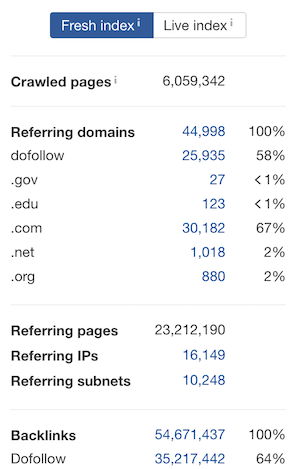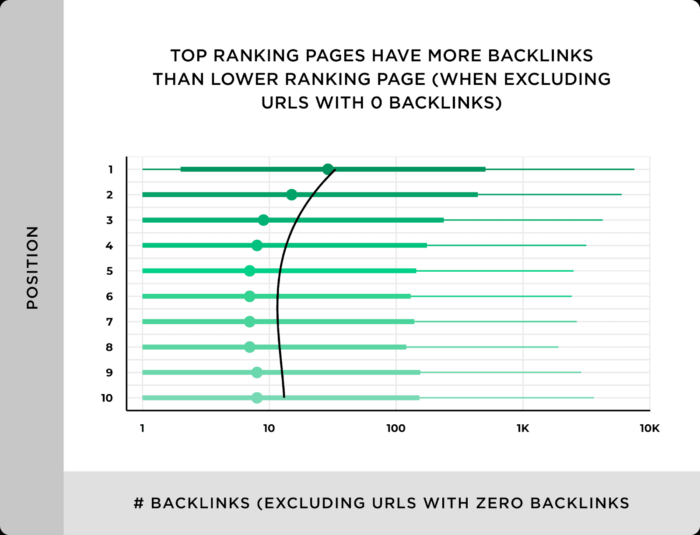
When I started my career in search engine optimization, I was 16 years old. And, just like most 16-year-olds, I didn’t worry much about search engine “consequences.” In my fairytale world, they didn’t really exist.
We all learn to know better as we age, but you have to keep in mind that I was naive. When I started my journey into the world of SEO strategy, I didn’t worry about the search engine rules … I just did whatever I wanted.
If you fast forward to today, I don’t leverage or practice black hat SEO or other negative SEO techniques when it comes to internet marketing. After all, there are plenty of above-board SEO tactics to turn to.
So, what is black hat SEO, exactly?
Black hat strategies involve everything from keyword stuffing and private blog networks (PBNs) to content automation and tiered link building.
Most of those strategies get a bad rap for a good reason.
But there is one thing you should keep in mind.
Black hat SEO is simply a good strategy gone wrong.
If I could do it all over again, I wouldn’t have dabbled in the art of the dark side. Why? Because if I had spent all that time and energy on legitimate search engine optimization tactics, I would have created a much larger long-term business.
I won’t bore you with the reasons you should avoid black hat SEO when trying to get better search results, as you already know them. Instead, I’m going to share with you seven crazy tactics (with data) that I leveraged as a kid.You’ll quickly see that I was a really creative kid … and it’s one of the main reasons I do well as an internet marketing expert today.
Crazy Tactic #1: TwitThis
What’s one thing that every blog has? Well, of course, every blog has content and a content marketing campaign … but they also have social media sharing buttons.
Facebook. Instagram. Twitter. Even LinkedIn. You see these social sharing buttons everywhere. But that wasn’t always the case.
When Twitter first came out, it didn’t have “tweet” buttons. Heck, people weren’t even calling them “tweets.”
So, my internet marketing team and I created our own Twitter social media sharing buttons that people could embed into their websites. We called these Twitter sharing buttons “TwitThis” (you can see what the original site looked like below):

How did it do? Well, so many people started embedding TwitThis buttons on their sites that the website once had a Google PageRank of 8 and over 54 million backlinks.

As you can see from the screenshot above, those 54 million backlinks came from 45,000 unique domains. But what’s more impressive than all this link building is the backlinks profile.

Just look at the image above. You’ll see that the site had 27 .gov and 123 .edu backlinks.
That’s not too shabby when it comes to link-building results—all from just creating a free tool that allowed people to place “tweet” buttons on their site.
The way that I spread the word about it was really interesting. I just went on Twitter, found all the popular sites leveraging it, and emailed the webmasters something like this:
Hey John,
I noticed that CNN has been leveraging Twitter lately. Have you thought about asking your users to share your content on Twitter so you can get even more traffic and improve your click-through rate?
We actually created a free tool called TwitThis that makes this whole process easy. We provide you with a simple code that you can paste into your HTML so that your website readers can easily share your content on the social media site Twitter, which will help CNN get more traffic.
Let me know if you have any questions.
Neil
Once I built up TwitThis to a high domain authority site, I was able to create subpages containing content related to popular terms at the time. Because the site had so much domain authority, they’d naturally rank high.
Crazy Tactic #2: Battlefield Bypass
I know what you are thinking. “What the heck is battlefield bypass?”
You’re probably already familiar with the search engine tactic involving buying expired domains. I took a bit of a different strategy when I was younger. I would buy only expired domains related to world history, as it increased the likelihood of .edu and .gov backlinks.
One of the domains I acquired was called battlefieldbypass.com. It was a website that used to be related to the Civil War.
When I acquired it, it had hundreds of link building ops, and many of them were from government-run websites.
I quickly acquired the site and turned it into an online casino site. Within a few months, the site ranked No. 2 on Google for the term “online casino,” which is still a highly competitive term on the search engines.
On the website, I listed out the top 10 online casinos that someone could sign up for. Whenever a user signed up because of my site, I got paid an affiliate commission. The site was averaging $40,000 to $60,000 a month. Apparently, I didn’t do a great job at fine-tuning the site for affiliate income, as the person ranking above me was making over $100,000 each month.
A lot of SEOs still leverage expired domains … but very few focus on ones that contain .gov and .edu links, even though they tend to be the most powerful. You also have to pay more for these expired domain names, but I never understood why someone would try to save a few bucks when the difference could mean ranking No. 1 on the search engine versus not.
Crazy Tactic #3: I Can Has Poker?
Do you remember a crazy cat website called I Can Has Cheezburger? I don’t know how popular the site is in the search results at the moment, but it used to generate around 500 million page views a month. Not too shabby for a site full of cat memes.
The audience was so loyal that I partnered with them to run a contest. The contest was a poker giveaway in which one person would win a two-night trip to Las Vegas with $500 in spending cash and free airfare for two individuals to and from Las Vegas.
I can’t find the page on I Can Has Cheezburger that discusses the contest (guessing they removed it), but here is a snapshot:
- Create a funny cat meme related to poker (they have a meme creator on their site).
- Embed the cat meme on your website to enter (the embed code linked back to my poker site).

Within a matter of days, I got over 2,000 link-building opportunities containing the phrases “poker” and “online poker” in the anchor text. I even had I Can Has Cheezburger rotate up the embed codes so that I could make the anchor text more natural.
Within a few days, my search engine rankings shot up to page 7 of the search engines for the search term “online poker.” Within a week, I was ranking on page 2, and within two weeks, I was ranking on page 1. I probably would have hit the No. 1 spot on the search engines, but I quickly got caught and Google pulled my ranking.
My total cost for the whole contest was under $10,000. Fifty percent of that was what I paid I Can Has Cheezburger for running the contest.
Crazy Tactic #4: WordPress Themes
What’s one thing all WordPress themes have in common? They have a footer link to the designer.

What’s one thing that most WordPress theme designers have in common? Most of them create themes out of passion and rarely try to make money from them, a different spin on the world of internet marketing. These themes do really well because the designers care about their work.
So, I thought it would be interesting to pay these theme owners $1,000 dollars to release an update of their already popular theme. The reason I targeted existing themes is that when they released an update, it would show up in the user’s WordPress admin, and they would just click a button to update the theme.
On the flip side, if I created brand new themes from scratch, there would be no guarantee that people would like the design and install it. For this reason, I only targeted existing themes that were popular.
Once a WordPress user added the new theme update, they would get some cool new features and, of course, a link back to one of my sites was placed in the theme footer.
The site I had the links go to was called Web Hosting Information.
At one point, the site ranked in the top three search results of Google for “web hosting.” Eventually, the search engines caught on, the site got slapped, and the search results rankings plummeted.
These days, I still use WordPress themes, but more so for branding. I want more people to know me as an internet marketing guru, so I pay theme companies to include “marketed by Neil Patel” links within their theme and, of course, each link-building op is nofollow so that I am not breaking Google’s rules.
Crazy Tactic #5: Operation Google Domination
The easiest tactic I deployed was this one. Do you remember Google Pages? It was when you could create a web page using Google’s domain name. That’s right. You could set up a site on “google.com.”
Google Pages doesn’t exist anymore. The closest thing I could find is this.
I used to set up search engine submission pages for highly competitive terms, like credit cards, auto insurance, and forex. From there, I would buy spammy blog links from Sponsored Reviews, Blogsvertise, and Pay Per Post.
From these networks, I would obtain PageRank 4 and 5 links for around $30 a pop and I would buy a few hundred at a time. In total, I spent $24,990 on paid links.
Within 60 to 90 days, I was on page 1 for the terms listed above, as well as other competitive key phrases.
The reason this tactic worked so well is that I was link building to Google’s own domain, which already contained tons of authority for search engine optimization.
Eventually, Google caught on, like they always do, and the pages stopped ranking.
Crazy Tactic #6: My Stat Counter
Are you familiar with Statcounter? It’s the popular analytics tool that was around way before Google Analytics. And, for Statcounter to give you stats, you have to add a counter to your site. The counter also contains a backlink to Statcounter.

Just look at their link building profile—over 1 billion links. That’s right … 1 BILLION.
To log into Statcounter, you once had to go to my.statcounter.com (that subdomain doesn’t exist anymore). So, I thought it would be clever to create my own stat counter type of site and called it MyStatCounter.com.
I got tons of search engine traffic from people who typed in “my.statcounter.com” incorrectly, which resulted in lots of people creating stat counters using my website.

When people would embed one of those hit counters into their site, they would automatically also link out to whatever site I wanted to promote. The embed code would contain third-party links, and I required that people leave it on, as my service was free.
Like most of the black hat SEO techniques I leveraged, my rankings shot up fast. It lasted for more than two years and worked so well that I was even selling links on My Stat Counter to other companies. It was great for my search engine marketing success.
I was smart about it as well. I would make sure that the anchor text was rotated. So, it seemed natural, and I never leveraged My Stat Counter for any of my marketing-related sites or blogs. I didn’t want to draw attention to it. Plus, when someone signed up, I would ask them what type of site they had so that I could place relevant third-party links versus random ones. Nonetheless, I eventually got caught and stopped using this tactic.
Crazy Tactic #7: Arbitraging Google
Based on the tactics above, you already know that if you have a lot of links pointing to one domain, you can rank for almost anything.
In the early days of search engine optimization, there weren’t Panda or Penguin penalties, and Google’s algorithms were a lot less sophisticated.
Back in 2003, Google released AdSense, a service people could use to monetize their own sites by placing Google ads on them.
So, I took one of my websites with a high domain authority, Advice Monkey (the site no longer exists), and scraped over 100 million Google search results pages. I took each of the results within their search engine and created millions of pages on my site that contained the same exact listing data.
My pages looked just like Google’s search results pages but with my AdSense ads all over them.
Within a month, I started to get traffic from lucrative terms that I scraped—such as “mesothelioma”—and I was making $943 to $2,592 a day from AdSense.
And, as you can probably guess, Google eventually shut me down for leveraging this tactic as well.
Can White Hat SEOs Learn From Black Hat Tactics?
While there’s a noticeable difference between white hat vs. black hat SEO, white hat SEO can take a page or two from the book of black hat SEO techniques.
Black hat strategies do work. They just aren’t as enduring as their white hat counterparts.
But there is still something to them.
In other words: Even though they’re shady, they can actually boost the recipient’s SEO.
Why is that important, though?
Because black hat SEO tactics are simply the unhealthy exaggeration of white hat SEO strategies.
To say it another way, black hat SEO takes white SEO strategies and amplifies them to dangerous levels.
As you can see by this comparison below, that is almost exactly what defines a black hat SEO strategy.

With black hat SEO tactics, relevant content turns into duplicate content, relevant links turn into irrelevant content, and well-placed keywords turn into stuffed keywords.
And that insinuates something wildly important.
Namely, it shows us that a good SEO strategy is similar to a black hat strategy. You just have to do it in proper moderation.
That means that you, the white hat SEO strategist, can learn a few tricks from black hat SEOs.
Even though black hat and white hat SEOs seem to be at odds, the only difference between their strategies is how much black hat SEOs exaggerate legitimate tactics that work for white hat SEOs.
With that in mind, here are three examples of black hat SEO strategies that you, the white hat SEO, can learn from.
Replicating Private Blog Networks (PBNs) the Right Way
If you know one thing about SEO, it’s backlinks.
Backlinks have long been one of the primary indicators Google uses to determine a website’s ranking.
In fact, the strength of your link-building strategy is the highest factor in Google’s decision-making process.
And according to one study, the more backlinks a page has, the better that page will rank on Google on average.

Since gaining backlinks to your web pages is such an influential strategy on the SERPs, black hat SEOs have leveraged the tactic as well.
But they do it in a slightly less reputable way.
White hat SEOs often rely on honest testimonials, guest blogging, and mutual partnerships to gain backlinks.
But for black hat SEOs, though, that’s not so much the case.
In fact, one of the primary black hat SEO methods for generating backlinks is the use of private blog networks.
PBNs have a network of inactive domains with pre-built SEO juice that they then use to link to your website.

Does it work?
Yes, it does.
Does it work for a long time?
Well, that depends on whether Google catches you. If Google finds out that a website is relying on backlinks from a PBN, then it will quickly demote that site from the rankings.
Fortunately, though, you can build backlinks honestly in much the same way.
You can pitch other publications, write testimonials, include your name on third-party directories, and create viral or share-worthy content.
Then your strategy will look more honest.

That means that you can generate the same attention as a black hat SEO without the risk of the Google police catching you and penalizing you.
That, after all, is the biggest downside to using black hat SEO techniques. They work, but they only work so long as no one knows what you’re doing.
For that reason, honest backlink building is a far better bet.
Keyword Sprinkling vs. Keyword Stuffing
I’m willing to bet your SEO friends have told you about the power of keyword research.
I hope you’ve taken their advice.
After all, keyword research really is a powerful tool in the world of SEO.
If you know which words people are typing into Google and you target those exact keywords, then you’ll be far more likely to rank in the position that you’re after.
Of course, black hat SEOs know that too.
And they’ve been using keywords to try and rank their websites ever since “keywords” became a thing.
The way they do it isn’t just annoying. It’s ineffective.
They keyword stuff.
Here’s what that looks like if the keyword is “best laptops,” for instance.

And here’s what that looks like if the targeted keyword is “firepit.”

That’s hard to read, isn’t it?
But that it’s difficult to read isn’t the only reason that these pieces of content won’t rank well on Google.
It’s also because Google is familiar with the keyword stuffing tactic and does everything in its power to demote websites that use it.
After all, Google doesn’t want a website to rank because it has the right words. They want it to rank because it has remarkable content.
This is what brought about the rise of semantic search (but that’s a topic for another day).
So, while you don’t want to stuff your pages with annoying and cluttered keywords, you do want to include the right keywords.
And to find the right keywords, you can use Ubersuggest.

Start by typing the keyword you want to target into the search box. Click “search.”
Now, click “keyword ideas” in the left sidebar. This will provide a list of suggested keywords based on the volume of searches for each one. Other data includes cost per click (CPC), paid difficulty, and search difficulty.
The keywords with the highest volume will appear at the top. If you want to review more keywords, click “related” or “questions” above the results.

Choose a few keywords to target throughout your content. Just pick two or three.
Then, sprinkle those on your page just enough that Google knows what you’re talking about. Do not stuff them everywhere that you possibly can like a black hat specialist.
Google wants to know what you’re talking about, but it won’t reward you for using keyword stuffing tactics to rise in the rankings.
If you keyword stuff, you’ll lose.
If you keyword sprinkle, you’ll win.
Choosing Your Brand Name Strategically
When white hat SEOs choose a brand name, they choose it simply because they like it.
Or maybe it sounds cool or sends a certain message.
Whatever the case, you probably chose your business name and domain name because it sounded good, would be easy to remember, and fits what your business is trying to accomplish.
Black hat SEOs, on the other hand, often choose a name because of how it will help them rank on Google.
They do keyword research to determine which keywords are the most popular within their chosen industry, and then they create a brand name that is an exact match to those keywords.
Why do they do this?
Well, if someone types “best digital marketer” into Google and that’s the black hat SEO’s business name, then they have a far better chance of showing up on Google.
After all, Google doesn’t automatically know whether you’re searching for a business name or a specific topic when you type in those words.
That gives black hat SEOs a shady advantage.
Consider this result where I typed in “sell house fast seattle” and this eerily similar result popped up.

As you can see, this tactic still works for black hat SEOs.
It works so well that it’s not really a black hat SEO strategy anymore. Many reputable companies use this same tactic to boost their rankings.
And it might not be a bad idea for your own business, either.
Consider, as an example, the similarity between my search for “the best digital marketer” and the domain of this result.

Or consider how Content Marketing Institute claimed the first position on Google at least partly because of the name of the domain that they own.

Of course, you don’t want to totally rely on your brand name to help your SEO.
You also need to generate backlinks, use the appropriate latent semantic indexing (LSI) keywords, and create remarkable content.
But, if changing your brand name to something more ideal for SEO can help your rankings, then it’s a small change to make for an automatic increase in traffic.
FAQs
Does black hat SEO still work?
Black hat SEO tactics still work like a charm today. These approaches will harm you more than benefit you, though. Google is quite robust, with built-in technologies for detecting low-quality material, keyword spam, and link spam. So, ultimately, it’s not worth it.
Along with this, Google is always rolling out new algorithm updates like the Spambrain update and Helpful Content Updates. Even if a practice works for now, a new update may render it obsolete or even damaging to your rankings.
What are any four factors of black hat SEO?
Four factors of black hat SEO include but are not limited to:
- Keyword stuffing: Stuffing a web page with keywords in an attempt to influence search engine rankings.
- Link spam: Efforts to affect Google Search results by using artificial connections.
- Sneaky redirects: Links that appear to be like any other page direct, but it goes to a different URL than requested.
- Duplicate content: The practice of copying and pasting the same content to other subdomains/domains, or pages to manipulate rankings.
What is a black hat vs. white hat SEO strategy?
To give you the quick version: White hat SEO methods are those that search engines promote, and black hat SEO practices are those that violate search engine guidelines.
Conclusion
I know some of these tactics may seem cool, and I may paint them to be glamorous, but they really aren’t. I am not proud of what I did, and if I could go back in time and tell myself one thing … it would be that I shouldn’t focus on any black hat tactics.
If I had focused all my energy on legitimate white hat SEO techniques, I wouldn’t have gone through as many sites. Instead, I would have had one much larger site that still existed today.
Sure, in the short run, I would have made less money. But I started so early that, in the long run, I would have been way ahead of everyone else.
The big lessons from this post should be:
- Be creative – The best marketers tend to be the most creative ones. It doesn’t mean you should break Google’s policies (you shouldn’t). But it means you need to think outside of the box to succeed (make sure you still follow the rules).
- Think long-term – Short-term tactics may seem fun, but eventually, you will get caught and you will have just wasted your time. I had months where I was making six figures from these tactics, but because they weren’t long-term, I also had really terrible months where I lost money.
- Learn from black hat tactics – There are a lot of marketers who leverage black hat techniques—not just in SEO, but in all forms of marketing. You shouldn’t necessarily copy these people, but do learn from them. Maybe you can take their tactics, make them white hat, and apply them to your business.
Have you seen any black hat SEO techniques that we could all learn from?

See How My Agency Can Drive More Traffic to Your Website
- SEO - unlock more SEO traffic. See real results.
- Content Marketing - our team creates epic content that will get shared, get links, and attract traffic.
- Paid Media - effective paid strategies with clear ROI.

Unlock Thousands of Keywords with Ubersuggest
Ready to Outrank Your Competitors?
- Find long-tail keywords with High ROI
- Find 1000s of keywords instantly
- Turn searches into visits and conversions
Free keyword research tool
